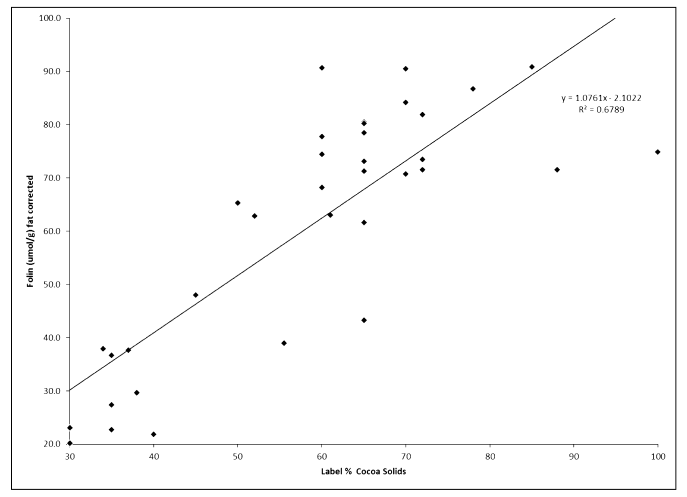The labeled percentage of cocoa solids prominently displayed on the front of many dark chocolate bar packages is directly correlated with the amount of health-promoting polyphyenol antioxidants, according to recently published research in the Journal of Functional Foods.
“Independent of the type of chocolate, manufacturer or country of origin, there was a positive linear correlation between polyphenol concentration and [percentage of] cocoa solids for 31” of the 33 chocolate bars examined by Joe Vinson and Matthew Motis from the Loyola Science Center at the University of Scranton.
The men used two antioxidant assays and corrected the value of the non-fat cocoa solids to uncover the one-to-one ratio of cocoa solids and polyphenols, which mounting scientific research has associated with reduced blood pressure, lower risk of heart disease, reduced risk of death from stroke and increased nitric oxide.
The finding is significant for marketers and consumers because it means the percentage of cocoa can be used as a quick reference to determine how healthy a dark chocolate bar is without flipping the package over and analyzing the nutrient content, the researchers said.
The men also used high-performance liquid chromatography to discover the labeled percentage of cocoa solids were highly correlated with the major flavanols catechin and epicatechin.
Notably, while country of origin did not influence the health benefit potential of a chocolate bar, whether the product was produced domestically or in a foreign country did matter.
“A comparison of 13 labeled domestic versus 20 foreign chocolate bars showed that there was a statistically significantly greater amount of Folin and [free radical antioxidant power] in the foreign products,” according to the study, which did not hazard an explanation for the difference.

Specifically, the study revealed “a paired comparison of domestic and foreign bars with identical % cocoa solids, 25, 60 and 72% also showed a significantly greater amount of antioxidants in the foreign products.”
Darker chocolate also could be healthier than sweeter milk chocolate because it “promotes more satiety, lowers the desire to eat something sweet and suppresses energy consumption,” the study adds.
While dark chocolate may provide heart-health promoting antioxidants and be healthier than milk chocolate, it is still high in calories, which can lead to weight gain and other health concerns, the researchers note.
“A recent long-term supplementation study showed a slight but significant weight gain at the high dose (25 g) of chocolate,” according to the studies. On the upside, the lower 6 g dose delivered the desired blood pressure lowering effect with no weight gain – once again underscoring the moderation is essential.
